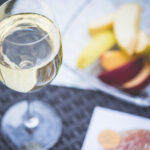
Though my years of wine study and experimentation (read: drinking), and the gift of a sensitive snoot might lead you to believe that my tasting skills are a kind of natural aptitude, the truth is I have had to work hard to develop comfort with the intimidating language that wine professionals and enthusiasts use to communicate. I come from a home that was not particularly of sophisticated tastes – our family gatherings were often outdoors and usually involved tents and hot dogs…and cheap beer. There were occasions where I spied a pack of wine coolers or a bottle of Merlot around but certainly no one was discussing nuances of style or wondering how the selections would pair with a sloppy joe.
I had zero preconceptions of fine-wine when I chose to study it professionally, but I lumbered forward with my Jelly Belly tasting expertise as my resumé and gradually stitched together an understanding of how the disparate elements of wine unite to make it so magical…and daunting. I have gathered these lessons and aha moments and am here to lay out the actual basics of wine tasting.
You may already have ways to communicate what you do and do not prefer, but as you build your wine vocabulary, you will realize that the real foundation is understanding and clearly communicating your preferences. As soon as you are ready to enrich your wine knowledge with the factors of geography, foreign language, horticulture, weather patterns and the history of our planet (through soil composition) you may want to move on to wine encyclopedias, but this is for the beautiful beginner with an open heart and a brave spirit.
Step One: Body
I consider this step one because it tends to be at once a straightforward term for wine newbies, as well as one of the most misunderstood. While using “body” as a rudimentary divining rod for your early choices will reliably return wines that align with your expectations, it may not be for the reasons you think. Wines that are full-bodied (high alcohol or sugar) tend to also show more intense fruit, spice, and aroma while light-bodied wines tend to be on the delicate side of the spectrum. The very specific term correlates well with its perceived broader connotation, but here’s what it really means.

The facts, maam: As a “measurement,” body refers to the actual mouthfeel of a wine, which is a direct indicator of alcohol or sugar content. Both elements lend viscosity to the liquid, which in turn becomes weight in the mouth.
What it tells us: When a wine’s body is the result of high alcohol (which is viscous and lends texture) it is an indication of a very ripe grape. The process of fermentation in very simplified terms converts sugar into alcohol, so the riper the grape at harvest, the higher the alcohol will be in the finished wine. Warmer climates produce more consistently ripe grapes with higher sugar content. Certain styles of wine – from slightly sweet to dessert level – have sugar content that is either so high at harvest that fermentation cannot utilize all of it before the yeasts die or it is added after fermentation is complete. If you consider the mouthfeel of sugar syrup you will see that sweeter wines have more texture than dry ones. The body, therefore, will correlate to sugar content – higher = fuller body and lower = lighter.
How to taste: If a wine is well balanced, even elevated levels of alcohol and sugar will not register as high on your tongue. What will help to determine the actual levels is the weight of the wine in your mouth. Think about body in terms of milk (from skim to cream). If you can compare the weight and feeling of each of those to wine, then you will understand what body is really referring to. Part of “tasting” body is visual as well. If you’ve ever heard someone comment on the “legs” in a glass, they are also alluding to its alcohol level. Legs became an indicator of quality during a time when boozy, manly reds were in vogue. But what they are really telling you is the rate of evaporation of the streams, which is a direct correlation to the alcohol level. This also contributes to a physical sensation on the tongue.
Step Two: The holy trinity of ACID-TANNIN-SUGAR
With body, these three factors create a wine’s structure. Contrary to many introductory approaches to wine, structure is more important than aromas and flavors when sorting out your favorites. These three factors are also what make a food pairing sing (you know it sings when there is a third flavor created by the combo) or just hang out well together.

The facts, maam: Acidity can be easily charted on a pH scale and shows up as mainly four types – tartaric, malic, lactic and citric. All four have slightly different profiles when tasted, but all lend the same freshness that we especially love in whites, bubbles, and some light summer reds. Tannins are polyphenols that come from the grape’s skin, seeds and stems. They can also be enhanced by oak treatment (fermentation and/or aging). They create the drying sensation that is associated with over-brewed tea, which when paired with fatty or heavy foods can act as a cutting or cleansing agent. Sugar is sugar and tends to be a polarizing aspect in wine. When added without integrity it will produce a wine with little character and of clumsy balance. When it is maintained in a natural process it can produce some of the world’s most incredible and sought after wines.
What they tell us: Acid levels reveal a wine’s genealogical and climatic origins. As grapes ripen, sugar levels increase while acid levels decrease. Although some varietals (Riesling for example) have such high natural acidity that even at full ripeness they maintain great freshness. Tannin levels hint at the grape varietal – grapes like Nebbiolo have very high astringency, while Pinot Noir have less – and length of skin contact or oak treatment. Unless a wine is a dessert style (where high sugar levels are deliberately and often painstakingly preserved), sugar is influenced by the ripeness of a grape when picked or by winemakers adding sugar to create a more approachable quaff.
How to taste: It is helpful to really understand what these each contribute and how they feel in your own mouth. When learning to taste, it can be helpful to color in a map of your own tongue while tasting lemon juice (acidity), over-brewed tea (tannin) and sugar syrup (…sugar). The old school tongue map has been outdated for decades and it is no longer believed that buds are specialized. But each sensation/flavor can present in a personal way on your palate and create sensations that help you pinpoint their influence when combined with the other factors. With a few generalities, acidity causes salivation on the sides of the tongue and tannin tends to dry out parts of the surface of the tongue as well as the gums. Sugar will show as weight always, but in quality dessert wines will also be balanced by high acidity or high alcohol, which is why it is beneficial to be able to identify actual sweetness on your own palate and to separate it from fruity aromas, which often present without corresponding sweetness.
Step Three: Identifying Aromas
This tends to be a source of overwhelm in early wine encounters. There are SO MANY chemical compounds that can come out of grapes and wood and the fermentation process. And there are even more personal memories associated with those compounds.

The facts, maam: Without a nose’s assistance, our tongues can only perceive salt, bitterness, sweetness, sourness and umami sensations. If you’ve ever been sick, you understand the difference that being able to smell makes in tasting “flavor.” It’s true that each taste receptor can only perceive one of these tastes, but their placement is not, as long believed, determined regionally on the tongue. Anything more complex than these basic sensations is an aroma and is either perceived by your nose through the front of your face or through the retro-nasal passage.
What it tells us: Aromas can be sorted into categories based on their chemical families, but when simplified, they can help us identify grape varietals, winemaking techniques and age range.
How to smell: Our sense of smell has evolved from being an essential element of survival and is no longer connected to the fight or flight part of our brains, which means smells are not interpreted as direct signals and must be filtered through our memory bank for identification. This is a blessing and a curse, but it helps to even the playing field between novice and expert tasters smellers. Though a bit of inference gives them a head start, the pros have developed a system for identifying aromas which involves suggesting individual scents to themselves and confirming or denying the chemical’s presence in a glass. This step of tasting is the least important for communicating your preferences with others but becomes a fun way to dive deeper into complexities as you move forward. Find an aroma wheel or a list of common wine aromas and sit down with a glass of wine looking for each as if you are reading through a checklist. It will begin as a laborious task but will get faster and faster as you become familiar with the process.
No matter where you are in your wine journey, I hope you’re having fun!

An Alaskan-New Yorker, Raven Adrian is an adult with a propensity to play. She is driven by all things that inspire laughter and curiosity which brings her very naturally to a career in wine and hospitality. She is a Certified Sommelier (CMS) and has spent 18 years knee-deep in the restaurant industry of NYC. Raven is a currently part of the sales team at Golden Ram Imports. You can follow her on instagram @grapenutter.


